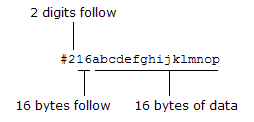TRACe[:DATA]
Syntax
TRACe[:DATA] <slot>, <name>, {<binary_block>|<value>, <value> [,<value>, . . . ]}
Description
This command downloads 32-bit floating-point values between -1 and +1 into volatile memory on the 34951A Isolated DAC Module in the specified slot. You can download between 2 and 512,000 points as IEEE-488.2 Binary Block data or as a comma-separated list of real numbers. Once you have downloaded the points to memory, you can adjust the amplitude and offset of the output to the desired levels.
|
|
Downloading floating-point values using TRACe[:DATA] is generally slower than downloading signed integer values (see TRACe[:DATA]:DAC command); however, floating-point values are more convenient, for example, when using trigonometric functions which return values between -1 and +1. |
Parameters
|
Name |
Type |
Range of Values |
Default Value |
|
<slot> |
Discrete |
{1|2|3|4|5|6|7|8} |
This is a required parameter |
|
<name> |
ASCII String |
A trace name consisting of up to 12 characters. The first character must be a letter (A-Z), but the remaining 11 characters can be letters, numbers (0-9), or an underscore ( _ ). Blank spaces are not allowed. |
This is a required parameter |
|
<binary_block> |
Numeric |
Peak-to-peak trace values between -1 and +1 represented as floating-point numbers in IEEE-488.2 Binary Block format. |
This is a required parameter |
|
<value> |
Numeric |
Peak-to-peak trace values between -1 and +1 represented as a comma-separated list of real numbers. |
This is a required parameter |
Remarks
The specified trace values correspond to the peak values of the trace output mode (see SOURce:MODE command). For example, "-1.0" corresponds to -1 Vdc in the VOLTage mode or -1 mA in the CURRent mode.
You can download between 2 and 512,000 trace points per 34951A module (each trace point requires 4 bytes of volatile memory).
You can store up to 32 traces in volatile memory on the 34951A module. Use the TRACe:DELete[:NAME] command to delete traces from memory.
For binary downloads, the syntax is a pound sign (#) followed by a non-zero digit representing the number of digits in the decimal integer to follow. This digit is followed by a decimal integer indicating the number of 8-bit data bytes to follow. This is followed by a block of data containing the specified number of bytes.
For example:

For binary downloads, you can specify the byte order (NORMal or SWAPped) using the FORMat:BORDer command.
After downloading the trace values to memory, use the SOURce:FUNCtion:TRACe[:NAME] command to select the active trace, the SOURce:FUNCtion:ENABle command to enable the trace mode, and then the OUTPut:STATe ON command to output the trace from the specified channels.
To set the gain of the trace output, use the SOURce:FUNCtion:VOLTage:GAIN and SOURce:FUNCtion:CURRent:GAIN commands.
To set the offset of the trace output, use the SOURce:FUNCtion:VOLTage:OFFSet and SOURce:FUNCtion:CURRent:OFFSet commands.
All trace data is stored in volatile memory and is therefore lost when power is turned off. In addition, trace data is not stored as part of the instrument state (see *SAV command) and you must download the trace points to memory again after recalling a stored state.
Examples
The following program segment downloads seven trace points to memory on the module in slot 4. The trace name is "NEG_RAMP".
TRAC
4,NEG_RAMP, 1, .67, .33, 0, -.33, -.67, -1
SOUR:FUNC:TRAC NEG_RAMP,(@4001,4002) !Assign
trace to channels 1 and 2
OUTP:STAT ON,(@4001,4002) !Enable
outputs from channels 1 and 2
SOUR:FUNC:ENAB ON,(@4001,4002) !Enable
trace mode on channels 1 and 2
The following command downloads four points to memory on the module in slot 3 (each trace point requires 4 bytes of volatile memory). The trace name is "TEST_WFORM".
TRAC 3,TEST_WFORM, #216 <binary data>